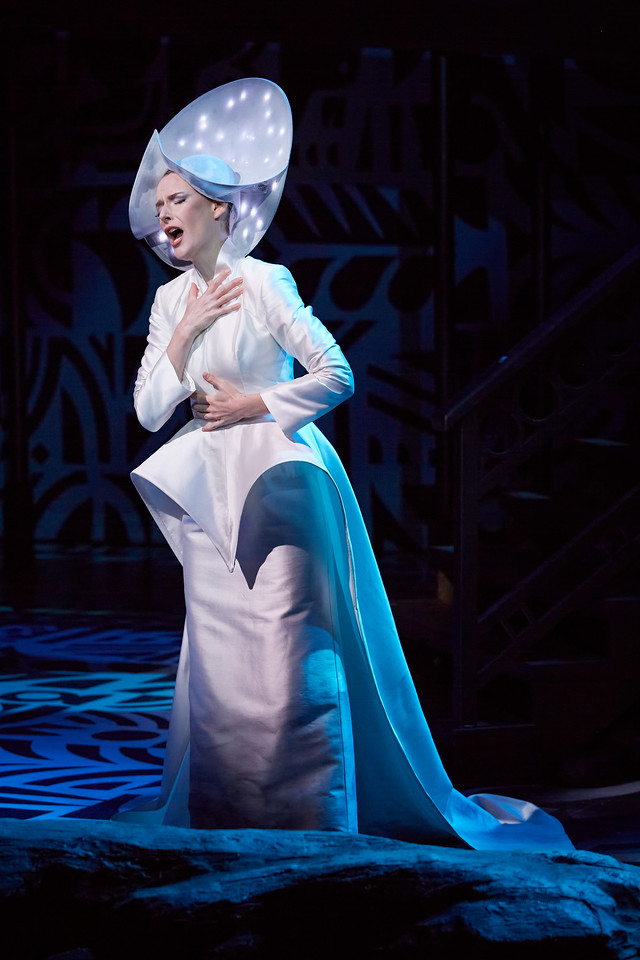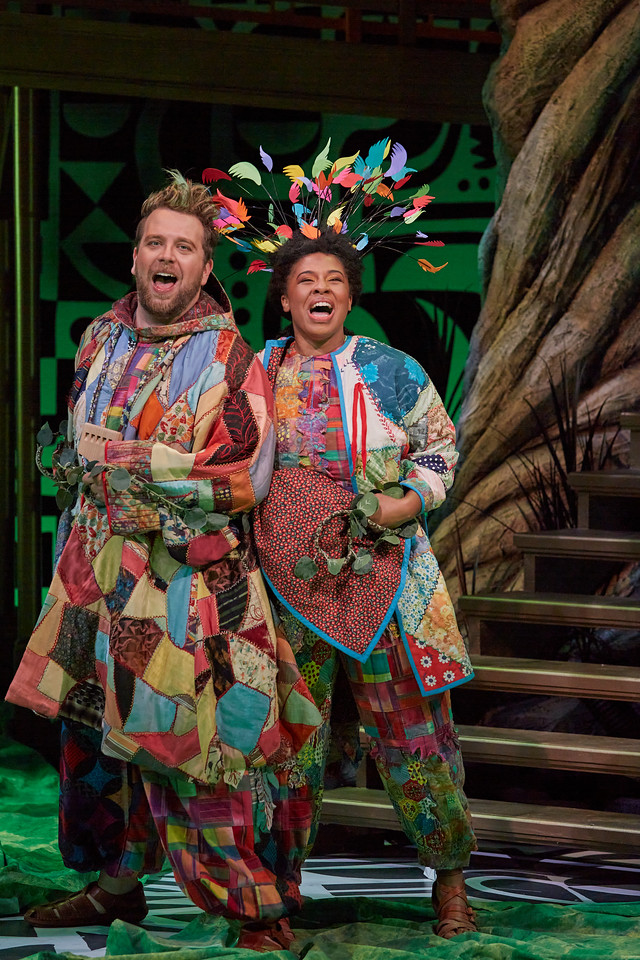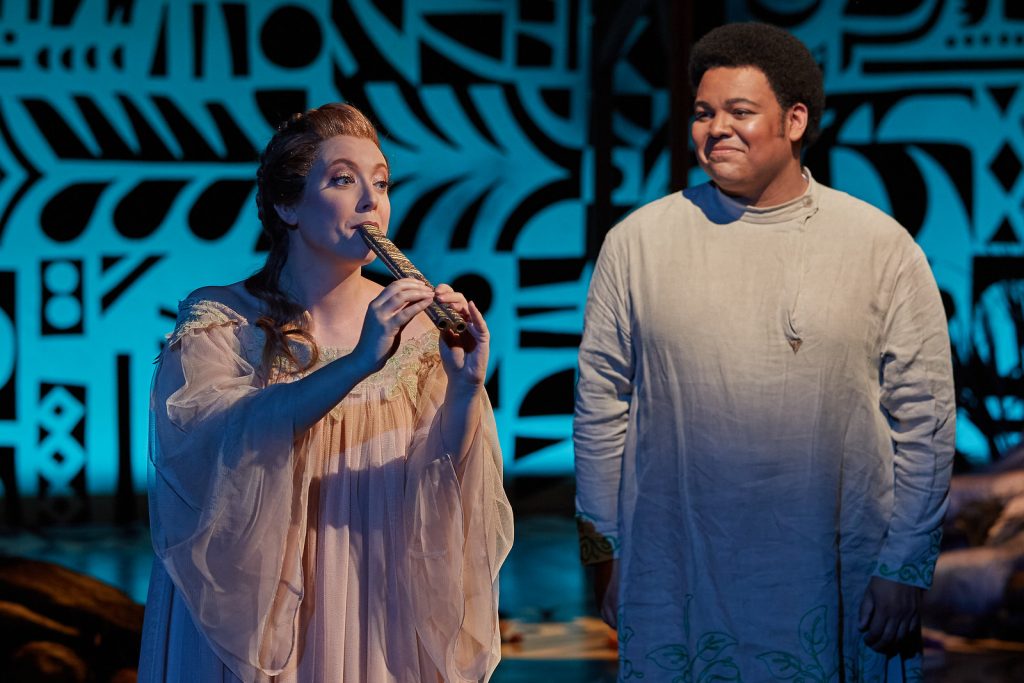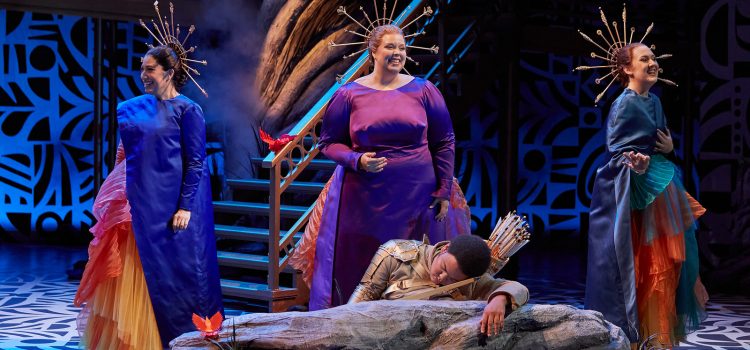By C.B. Adams
As Stage Director Omer Ben Seadia writes of “The Magic Flute” in this season’s gorgeously designed program for Opera Theatre of St. Louis (OTSL), “We come back to ‘The Magic Flute’ in every generation, so that we too can look around and decide for ourselves what the world should look like and who we want to be in the world.”
And like its balletic counterpart cum cultural chestnut, “The Nutcracker,” Mozart’s opera is indeed wide, magical and appealing enough to invite interest, interpretation and relevance from generation to generation since it premiered in 1791. As Paul Simon more recently put it, “…every generation throws a hero up the pop charts / Medicine is magical and magical is art…”

It’s tempting to play the wonk and dwell on how and why this singspiel in two acts has enjoyed such a long run. But the more pressing question is whether OTSL’s 2022 production is up to the demanding challenge and delivers a Flute that is as relevant as it is magical and. The short answer is yes.
If you were at the May 28th performance and seek outside validation of why you and almost everyone else – across several generations – laughed, clapped and all-but sang along to the Queen of the Night’s famous aria (if only we were all coloratura sopranos), then consider yourself validated.
A closer look, however, reveals a subtle, cerebral interpretation of this classic – one that takes some interesting risks and rewards the careful observer. As film director/writer/producer Alan Parker once said, “It’s just as hard to make a bad film as a good one…” The same holds true for opera productions.
The pros at OTSL faced a million decisions that coalesced into this take on a canonical opera. One would have loved to have listened to the discussions between Seadia, Set Designer Ryan Howell and Lighting Designer Christopher Akerlind as they explored how to create the set, which is deceptively simple.
It was anchored by the twisted trunk of a tree – shades of Keebler Elves – that served as the synecdoche for the entire enchanted forest. The tree was flanked by an elevated, wood-toned walkway and staircase that was so ordinary as to become essentially ubiquitous, if not invisible.
The set’s standout element is the busy-patterned, bi-color, batik-like back wall. At first glance, the wall seems more fitting for “The Lion King” than an enchanted forest. But cue the lights. Throughout the opera, the use of light brings some of the no-so-random shapes to life as owls, heads or all-seeing eyes.
Clever in the best sense of the world, and never so obvious as to detract from the overall performance. The use of suspended light bars in Act II was spectacularly effective, especially since this half of the opera relates to light relative to Act I’s focus on darkness.
Jessica Jahn, costume designer, and Tom Watson, wig and make-up designer, created costumes that hinted at a disparate variety of influences. The costume for Sarastro, the High Priest of the Sun, for instance, enveloped Adam Lau in a spectral cape that was part David Bowie in “The Man Who Fell To Earth” and part Balok from the “The Corbomite Maneuver” episode of “Star Trek.”

It would have been easy to rely on a more traditional, Egyptian-theme for Sarastro. At Sarastro’s first entrance, his costume was slightly off-putting, but as Lau stiffly moves about, his costume’s next-generation pharaonic vibe makes sense. Again, this is a cerebral production of the Flute.
The three Workers also sported spacey costumes that are a mash-up of brown Carhartt overalls and bowel-shaped hoods reminiscent of the Jawas in “Star Wars.” Not quite as effective was The Queen of the Night’s second act costume that included a lighted iconographic halo. Using lights to depict a character associated with darkness seems a bit gimmicky, but not overly detracting thanks to the powerful performance of Jeni Houser.
The Flute’s story is simply silly by today’s standards. Its magic lies in the music by Mozart. And the magic in this production is the cast. With a smooth assist from the orchestra led by Rory Macdonald, they almost make the set, costumes and lighting superfluous.
It’s easy to emphasize Johnathan McCollough’s Papageno because the character has all the best, funniest lines and he gets to romp through his scenes – so much Falstaffian id mucking about with all the other Flutian egos. The world of opera could use more laughter like this. McCollough plays his Papageno as a well-rounded, hedonistic nature boy. Angel Riley was the perfect counterpoint and foil with her Papagena as his devilish, spunky love-interest.
Balancing Papageno’s comic antics is the more serious, eyes-on-the-prize prince, Tamino, sung by tenor Joshua Blue. As the central character, Blue’s performance was silky, entrancing and believable.
Equally strong was Houser as The Queen of the Night – part Borg Queen and part Wicked Stepmother (lighted headdress notwithstanding.) Houser’s coloratura “Vengeance Aria” is a show-stopper, as it is intended to be.
Erica Petrocelli sings Pamina, the Queen’s daughter. Pamina is both vulnerable in a girl-tied-on-the-tracks sort of way and fiercely strong-willed like Elsa in “Frozen.” Petrocelli pulls off that balance with a performance equal to, if not surpassing, her queen mum.
The basso Lau convincingly and captivatingly sings Sarastro. Lau’s coldly controlled presence paired with his deep, resonate, voice imbues Sarastro with gravitas and other-worldliness.
The art of opera is a gestalt, composed of all of the theatrical arts, and especially music and voice. Magical is art. OTSL’s 2022 production of “The Magic Flute” joins the ongoing lineage of productions that precede it. And if anyone of this generation questions the need for another, borrow the title from the second volume of Elvis’s gold hits and say, “50,000,000 Flute Fans Can’t Be Wrong.”

“The Magic Flute” is presented in repertory by Opera Theatre of St. Louis June 8-26 at the Loretto-Hilton Center, 130 Edgar Road, St. Louis. It is performed in English with projected English subtitles and runs 2 hours, 30 minutes. Members of the St. Louis Symphony Orchestra accompany the performance. For dates, tickets and more information, visit: https://opera-stl.org/whats-on/the-magic-flute/

CB Adams is an award-winning fiction writer and photographer based in the Greater St. Louis area. A former music/arts editor and feature writer for the St. Louis Globe-Democrat, his non-fiction has been published in local, regional and national publications. His literary short stories have been published in more than a dozen literary journals and his fine art photography has been exhibited in more than 40 galley shows nationwide. Adams is the recipient of the Missouri Arts Council’s highest writing awards: the Writers’ Biennial and Missouri Writing!. The Riverfront Times named him, “St. Louis’ Most Under-Appreciated Writer” in 1996.



